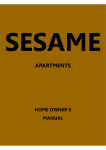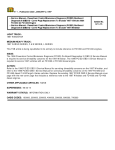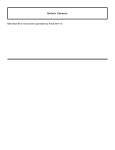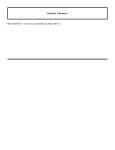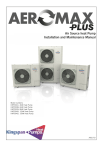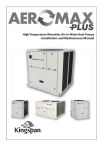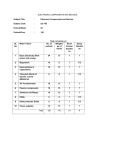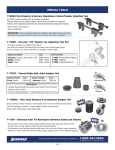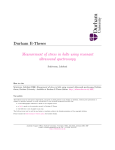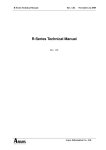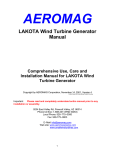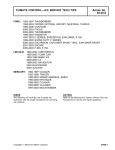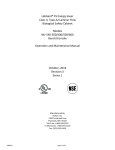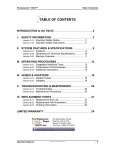Download 1999 Ford Technical Service Bulletins
Transcript
99-2, Publication Date: JANUARY 26, 1999 MEDIUM/HEAVY TRUCK: 1996-98 LOUISVILLE ISSUE: There may be excessive wear of either the right front or left front tire on some vehicles equipped with a 14600, 16000, 18000, or 20000 lb front axle. This may be caused by the front and/or rear axle not being perpendicular to the frame. ACTION: Align front axle to be perpendicular to frame. This should reduce tire scrub. Refer to the following Service Procedure for details. SERVICE PROCEDURE 1. Check total vehicle alignment. 2. On vehicles with tandem rear axles, correct any misalignment as specified in the appropriate Louisville/AeroMax Workshop Manual, Section 204-00, or refer to TSB «98-21-15» for vehicles equipped with Hendrickson walking beam suspensions. 3. If front axle camber is out-of-specification, replace I-Beam per Workshop Manual, Section 204-01. (Refer to Workshop Manual, Section 204-00, for specification). 4. To align the front axle, loosen the U-bolts, reposition the front axle, and torque front axle U-bolts to the torque specified below. The front axle side-to-side variation to the rear axle should be not more than 3mm (1/8") or the set back should be less than 0.1 degree. Reset toe to 0.8mm (1/32"). 5. 3/4" U-bolts are torqued to 339-407 N-m (250-300 lb-ft). 6. 7/8" U-bolts are torqued to 542-651 N-m (400-480 lb-ft). 7. The front axle U-bolts must be checked and tightened again after 800-1600 km (500-1000 miles). OTHER APPLICABLE ARTICLES: 98-21-15 WARRANTY STATUS: Eligible Under Basic Warranty Coverage LABOR ALLOWANCE DEALER CODING OASIS CODES: 303000, 306000, 390000 99-3, Publication Date: FEBRUARY 15, 1999 MEDIUM/HEAVY TRUCK: 1992-97 L SERIES ISSUE: Loose or cracked rear suspension crossmember(s) may be evident on some vehicles. This may be caused by insufficient clamping force produced by the upper and lower bolts that attach the crossmember(s) to the frame-mounted gusset . ACTION: If the crossmember is cracked, it requires replacement. If the crossmember is loose, remove torque rod and existing attaching hardware. Enlarge the holes in the crossmember and gusset to 20.50/21.00mm (0.807/0.827") diameter. Install the 0.75" diameter hardware and torque the nuts to 350-400 N-m (260-300 lb-ft). If the holes in the crossmember or the gusset are elongated larger than 19mm (0.75"), the crossmember requires replacement (part number is located on the flange of the crossmember). Refer to the 1996 L-Series Service Manual, Page 02-01-11, Item 3, for a representative illustration showing the crossmember installation. Refer to the appropriate model year L-Series Service Manual for proper installation of service parts and torque specifications. NOTE: ONE WASHER MUST BE INSTALLED UNDER THE BOLT HEAD AND ONE WASHER MUST BE INSTALLED UNDER THE NUT. OTHER APPLICABLE ARTICLES: NONE WARRANTY STATUS: Eligible Under Basic Warranty Coverage LABOR ALLOWANCE DEALER CODING OASIS CODES: 304000, 305000, 390000 99-4, Publication Date: FEBRUARY 19, 1999 MEDIUM/HEAVY TRUCK: 1996-98 AEROMAX, LOUISVILLE ISSUE: The radiator coolant supply tank vent hose nipple may break off at the tank connection. Engine vent hose routing may allow the engine to pull on the tank nipple during engine articulation. ACTION: Replace the coolant supply tank and reroute the engine vent hose. Refer to the following Service Procedure for details. SERVICE PROCEDURE 1. Replace the coolant supply tank and associated hardware. Refer to the appropriate Louisville/AeroMax Workshop Manual, Section 303-03, or Service Manual, Section 03C-03. 2. Loosen the engine clip as necessary where the engine vent hose line is routed through and add 25.4mm (1") slack between the hose clip and the coolant tank nipple. The vent hose is sufficiently long to allow the 25.4mm (1") slack. Refer to «Figure 1». 3. Retighten engine clip to retain the vent hose. OTHER APPLICABLE ARTICLES: NONE WARRANTY STATUS: Eligible Under Basic Warranty Coverage LABOR ALLOWANCE DEALER CODING OASIS CODES: 206000, 402000 Figure 1 - Article 99-4-4 99-6, Publication Date: MARCH 19, 1999 MEDIUM/HEAVY TRUCK: 1996-98 AEROMAX, LOUISVILLE ISSUE: The Ready Line Access Door Spring (XC4Z-MF062A-AA) may be broken. ACTION: Replace the spring with a revised Spring (XC4Z-MF062A-AB). OTHER APPLICABLE ARTICLES: 98-20-23 WARRANTY STATUS: Eligible Under Basic Warranty Coverage LABOR ALLOWANCE DEALER CODING OASIS CODES: 108000, 111000, 112000, 190000 99-10, Publication Date: MAY 14, 1999 MEDIUM/HEAVY TRUCK: 1997-98 LOUISVILLE ISSUE: High floor heat may arise during idle with PTO in operation. During PTO operation with the vehicle stationary, in-cab temperatures can cause driver or passenger discomfort. ACTION: Install a thermal/heat barrier shield under the floor trim/mats to provide additional insulation. Refer to the following text for details. Use Heat Barrier LF198 that can be obtained from Lydall Westex (248-952-5570, 8:00am-5:00pm EST) and install with aluminum side down. Material required per cab is two (2) 1.8 square meter (6 square feet) sheets. Cut to fit using floor trim as guide. Assure sufficient clearance around brake pedal, clutch pedal, and accelerator so that operation of these controls is not affected. NOTE: LIFT FLOOR MAT/TRIM UP, BEFORE PLACING HEAT BARRIER SHIELD DOWN, THEN COVER WITH MAT/TRIM. OTHER APPLICABLE ARTICLES: NONE WARRANTY STATUS: INFORMATION ONLY OASIS CODES: 101000, 107000, 111000 99-12, Publication Date: JUNE 7, 1999 FORD: 1996-97 ASPIRE, PROBE, THUNDERBIRD 1996-99 CONTOUR, CROWN VICTORIA, ESCORT, MUSTANG, TAURUS LINCOLN-MERCURY: 1996-97 COUGAR 1996-98 MARK VIII 1996-99 CONTINENTAL, GRAND MARQUIS, MYSTIQUE, SABLE, TOWN CAR, TRACER 1999 COUGAR LIGHT TRUCK: 1996 BRONCO 1996-97 AEROSTAR, F SUPER DUTY, F-250 HD, F-350 1996-99 ECONOLINE, EXPLORER, F-150, F-250 LD, RANGER, VILLAGER, WINDSTAR 1997-99 EXPEDITION, MOUNTAINEER 1998-99 NAVIGATOR 1999 SUPER DUTY F SERIES MEDIUM/HEAVY TRUCK: 1996-97 CARGO SERIES 1996-98 AEROMAX, F SERIES, LOUISVILLE This TSB article is being republished in its entirety to add vehicles and model years, and to revise the procedure to use Ford brand service parts. ISSUE: Ford Motor Company has released a private labeled material to be used for iron particle/acid rain service repairs. ACTION: To remove these particles/contaminates, use ONLY the following products and procedure. No polishing, compounding, color sanding, or repainting should be done before this procedure is performed. This procedure uses products that are acidic, alkaline, and neutral and must be properly mixed and used in their specific order. Refer to the following Service Procedure for details. SERVICE PROCEDURE NOTE: ANY CHANGES TO THIS PROCEDURE WILL CAUSE AN INCOMPLETE OR UNSATISFACTORY REPAIR. THE USE OF ANY OTHER PRODUCT OR PROCEDURE MAY CAUSE DAMAGE TO ALUMINUM OR PAINTED SURFACES. NOTE: THE PRODUCTS USED TO REMOVE SURFACE CONTAMINATION FROM PAINT ARE DESIGNED FOR VEHICLES WHICH HAVE EXPERIENCED EXPOSURE FOR LESS THAN 120 DAYS. VEHICLES THAT EXCEED 120 DAYS OF EXPOSURE MAY REQUIRE THE PROCEDURE BE REPEATED TO RESOLVE THE CONCERN. ONCE THIS PROCEDURE IS COMPLETED, IT MAY BE NECESSARY TO PERFORM POLISHING OR REFINISHING PROCEDURES AFTER VEHICLE INSPECTION. IDENTIFICATION Ferrous metal particles (hot iron dust) are generated by manufacturing facilities, rail shipments, etc. These particles mechanically bond to a vehicle's painted surfaces. Moisture and temperature combine with particles to create a chemical reaction. This reaction creates an acid, causing the iron to corrode and enter the paint surface. Industrial fallout and acid rain generate corrosive compounds that fall on the vehicle's painted surfaces. When subjected to moisture and temperature, chemical compounds are created that etch the paint surface. To assist in identifying surface contamination, use a (Tandy-Radio Shack #63-851) 30x lighted magnifier. Concern Description Ferrous Metal Light Colored Vehicles: Small orange stains the size of "mechanical pencil lead." The surface is rough to the touch. Dark Colored Vehicles: Small white or silver appearing dots with a rainbow ring around the dot. The surface is rough to the touch. Industrial Fallout Water spots with ferrous metal are present and the surface is rough to the touch. Acid Rain/Etching Surface will exhibit irregular discolored spotting. Dark colored vehicles may exhibit cloudy or graying spots where the acid has begun to etch the paint. Extreme cases of etching will be visible and may be felt. Decontamination Procedure Use Ford Acid Neutralizer, Alkaline Neutralizer, and Detail Wash to decontaminate and neutralize the paint surface. Perform the procedure only on vehicle when the paint surface temperature is cool. Follow the step-by-step procedure listed below to perform this service operation. 1. Rinse off dust, dirt, and debris with cold water. Flush liberally. 2. Prepare Acid Neutralizer by mixing 8 parts of water to 1 part Acid Neutralizer in a bucket. 3. Use a clean wash mitt and apply mixture of Acid Neutralizer to the entire vehicle starting at the top of the vehicle working toward the side. Keep the vehicle wet with solution, lightly agitating for 5 to 7 minutes. For vehicles with severe conditions, work the product for up to 8 minutes. NOTE: USE A SEPARATE MITT FOR EACH PRODUCT. DO NOT INTERMIX MITTS. 4. Rinse the vehicle thoroughly with cold water to remove Acid Neutralizer. 5. Dry only the horizontal surfaces of the vehicle at this time. Do not dry glass. 6. Alkaline Neutralizer is ready to use. Do not mix with water. Pour the contents into a dispenser squirt bottle. Squirt Alkaline Neutralizer directly onto a clean wash mitt. Do not spray Alkaline Neutralizer on the painted surface. Apply the product to the vehicle, keeping the areas wet and lightly agitated for 5 to 7 minutes. For vehicles with severe conditions, work the product for up to 8 minutes. 7. Rinse the vehicle thoroughly with cold water. 8. Prepare Detail Wash by mixing 29.5 mL (1 ounce) of Detail Wash to 3.7 L (1 gallon) of water. 9. Shampoo the vehicle with Detail Wash using a clean wash mitt. Rinse the vehicle with cold water and dry the vehicle completely. NOTE: DETAIL WASH IS A HEAVY DUTY NEUTRAL SHAMPOO CONCENTRATE (pH 7) AND MAY BE USED FOR HAND CAR WASHING OR IN AUTOMATIC CAR WASH SYSTEMS. Surface Correction Following Decontamination/Neutralization 1. Visually inspect paint surface for evidence of removal of ferrous metal particles and water spots. NOTE: ACID RAIN DISCOLORING OR ETCHING WILL REQUIRE ADDITIONAL PROCEDURES DEPENDENT ON DEPTH OF DAMAGE; POLISHING, BUFFING, COLOR SANDING, OR IN EXTREME CASES, REFINISHING. 2. Do Not Intermix Buffing Products. Use only one manufacturer's products. 3. Always follow the manufacturer's product usage sequence. Use the appropriate recommended pad at recommended buffing speeds as specified by the product manufacturer. NOTE: WHEN ATTEMPTING TO AFFECT A REPAIR BY BUFFING, POLISHING, OR COLOR SANDING, DO NOT REMOVE AN EXCESS OF 0.3 MIL OF PAINT FILM OR REFINISHING WILL BE REQUIRED. USE OF AN ELECTRONIC MIL GAUGE (ROTUNDA 164-R4025) IS HIGHLY RECOMMENDED TO INSURE CONTROL OF PAINT FILM REMOVAL. 4. Use a dual action sander with a Velcro backing plate and a foam pad to fine polish and remove any swirls created by a rotary buffer or pad. 5. Use an alcohol and water mixture (1 to 1 ratio) to clean the buffed areas and to verify removal of scratches and swirls before application of the final polish. OTHER APPLICABLE ARTICLES: NONE SUPERSEDES: 97-21-3 WARRANTY STATUS: Eligible Under The Provisions Of 12 Month/12,000 Mile Basic Warranty Coverage LABOR ALLOWANCE DEALER CODING OASIS CODES: 106000, 190000 Figure 1 - Article 99-12-10 99-14, Publication Date: JULY 6, 1999 FORD: 1992-99 F & B SERIES 1993-97 L SERIES This TSB article is being republished in its entirety to add model years and service parts. ISSUE: A vibration or "buzz" may be experienced through the throttle pedal on some vehicles equipped with an FD1060 or FD1460 midrange Diesel engine. This may be caused by engine vibrations being transmitted up the mechanical linkage to the throttle pedal. ACTION: Replace the current mechanical linkage throttle system with a revised throttle cable system. The throttle cable system does not transmit engine vibrations to the throttle pedal. Refer to the following text for details. The complete installation procedure for the revised throttle cable system is provided in the Service Kit. NOTE: THE NEW THROTTLE CABLE SYSTEM PROVIDED IN THIS TSB ARTICLE CAN BE USED ON F, B, AND L-SERIES VEHICLES EQUIPPED WITH: AN FD1060 OR FD1460 ENGINE WITH BOSCH INLINE (P-TYPE) FUEL INJECTION PUMP A MANUAL OR ALLISON MT/AT AUTOMATIC TRANSMISSIONBUT CANNOT BE USED ON F, B, AND L-SERIES VEHICLES EQUIPPED WITH: AN ALLISON MD (ELECTRONIC) AUTOMATIC TRANSMISSION (THE MD TRANSMISSION REQUIRES AN ELECTRONIC THROTTLE POSITION SENSOR WHICH IS CURRENTLY MOUNTED ONTO THE THROTTLE PEDAL ASSEMBLY. THE NEW THROTTLE PEDAL ASSEMBLY DOES NOT HAVE A PROVISION FOR MOUNTING THIS SENSOR.) AN FD1060 160 HP ENGINE WITH THE BOSCH ROTARY-TYPE FUEL INJECTION PUMP NOTE: ON 1992 AND 1993 F, B, AND L-SERIES VEHICLES, SAFETY RECALL 93S72 MUST BE PERFORMED FIRST BY AN AUTHORIZED FORD DEALER BEFORE THE NEW THROTTLE CABLE SYSTEM CAN BE INSTALLED. THIS CABLE SYSTEM IS NOT COMPATIBLE WITH THE ORIGINAL THROTTLE RETURN SPRING SYSTEM. NOTE: FOR L-SERIES VEHICLES ONLY: IF THE VEHICLE IS EQUIPPED WITH AN FD1460 ENGINE AND OPTIONAL ETHER COLD START SYSTEM, THEN IT WILL BE NECESSARY TO RELOCATE BOTH THE ETHER BOTTLE AND WINDSHIELD WASHER FLUID RESERVOIR. THESE COMPONENTS WILL HAVE TO BE RELOCATED TO PROVIDE THE NECESSARY CLEARANCE FOR THE NEW THROTTLE CABLE SYSTEM. THE NEW POSITION OF THESE COMPONENTS WILL THEN BE THE SAME AS THAT ON VEHICLES EQUIPPED WITH THE FD1060 ENGINE. INFORMATION REGARDING RELOCATION OF THE ETHER START SYSTEM AND WASHER FLUID RESERVOIR IS PROVIDED IN THE SERVICE KIT. CAUTION: ONCE THE NEW THROTTLE CABLE SYSTEM IS INSTALLED, THE OPERATION OF THE ENTIRE THROTTLE SYSTEM MUST BE THOROUGHLY CHECKED TO ENSURE PROPER OPERATION. WITH THE ENGINE RUNNING, DEPRESS THE ACCELERATOR PEDAL TO ITS FULL EXTENT, THEN SLOWLY RELEASE THE PEDAL. "SLOWLY RELEASE" MEANS MOVEMENT NO FASTER THAN APPROXIMATELY 2 SECONDS PER INCH. THE THROTTLE PEDAL MUST RETURN COMPLETELY TO IDLE POSITION WITHOUT ANY INDICATION OF DRAGGING OR BINDING. OTHER ENGINE COMPARTMENT COMPONENTS (HOSE, WIRING, ETC.) MUST NOT CONTACT ANY MOVING PART OF THE ACCELERATOR CONTROLS. CAUTION: THE INSTALLATION OF THE THROTTLE CABLE SERVICE KIT REQUIRES DRILLING NEW COMPONENT MOUNTING HOLES IN THE CAB FLOOR. IT IS VERY IMPORTANT THAT ANY WIRING HARNESSES, HOSES, AFTERMARKET ACCESSORIES, ETC. THAT MAY INTERFERE WITH THE DRILLING OPERATION BE TEMPORARILY REPOSITIONED OR REMOVED. THE FLOOR PAN AREA INSIDE AND OUTSIDE OF THE CAB MUST BE CHECKED TO MAKE SURE SUFFICIENT CLEARANCE IS OBTAINED. The Throttle Cable Retrofit Kit (F7HZ-9728-BA) for F- and B-Series vehicles contains the following: One (1) Engine Bracket One (1) Throttle Cable One (1) Engine Lever One (1) Throttle Pedal One (1) Dust Shield Three (3) 1/4" Bolts Six (6) 1/4" Nuts Six (6) 1/4" Washers The Throttle Cable Retrofit Kit (F8HZ-9728-BA) for L-Series vehicles contains the following: One (1) Engine Bracket One (1) Throttle Cable One (1) Engine Lever One (1) Throttle Pedal One (1) Dust Shield Three (3) 1/4" Bolts Seven (7) 1/4" Nuts Seven (7) 1/4" Washers Install a Cover Plate (F7HZ-80113A52-AA) over the hole in the cab floor previously utilized by the linkage mechanism. The cover plate should be attached to the cab floor by four (4) Screws (55927-S2). OTHER APPLICABLE ARTICLES: NONE SUPERSEDES: 97-20-22 WARRANTY STATUS: Eligible Under Basic Warranty Coverage LABOR ALLOWANCE DEALER CODING OASIS CODES: 497000, 703000, 703100, 703200, 703300

















